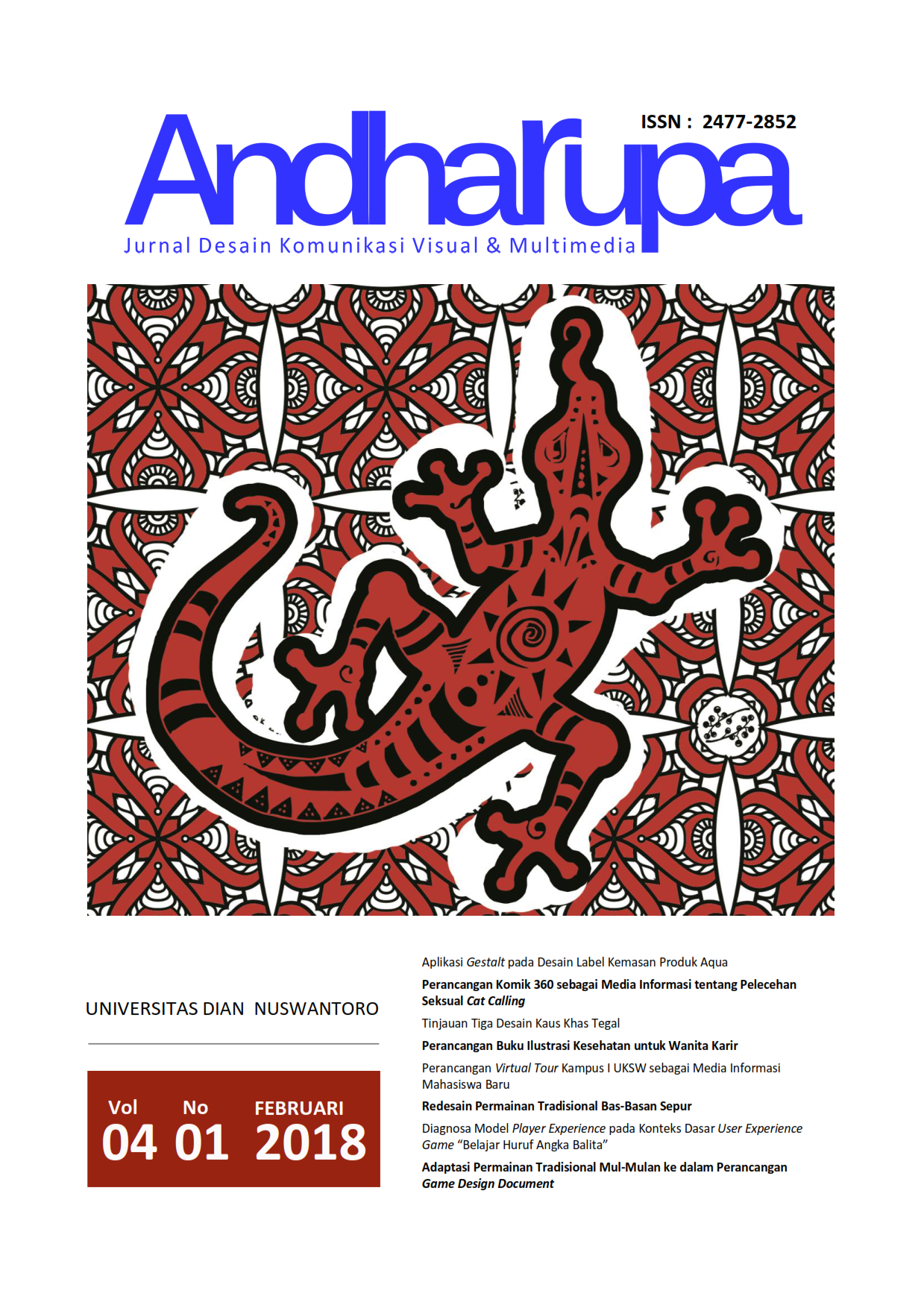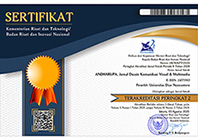Diagnosa Model Player Experience pada Konteks Dasar User Experience Game "Belajar Huruf Angka Balita"
DOI:
https://doi.org/10.33633/andharupa.v4i01.1688Abstract
AbstrakGenerasi muda seperti anak-anak merupakan salah satu pengguna game yang mesti diperhatikan terkait dengan proses tumbuh kembang karakter anak. Seiring dengan kemunculan game digital, game edukasi merupakan salah satu Genre game dan media interaktif yang mampu memberikan metode pembelajaran yang berbeda dari yang konvensional. Game Belajar Huruf Angka Balita merupakan salah satu game digital berbasis edukasi yang bisa ditemui dan diunduh di PlayStore secara gratis dimana sampai tahun 2017 telah diunduh sebanyak seratus ribu unduhan dalam konteks game lokal. Salah satu yang diunggulkan dalam konten game ini yakni fitur yang sederhana sehingga mudah dipahami oleh pengguna game terutama anak-anak. Penelitian ini menawarkan kajian menggunakan model Player experience dalam konteks dasar User Experience dengan didukung menggunakan metode kuantitatif-kualitatif serta pengamatan. Luaran yang dihasilkan pada penelitian ini berupa hasil kajian melalui model Player experience dalam konteks pengalaman pengguna game Belajar Huruf Angka Balita yang bermanfaat sebagai rujukan pengembangan game edukasi serupa.Kata Kunci: balita, game, media edukasi, player experience, user experienceAbstractYoung generation like children is one of the game users who must be considered related to the process of developing the character of the child. Along with the emergence of digital games, educational games is one Genre of games and interactive media that is able to provide different learning methods than the conventional. Game learning the Figures of Toddlers is one of the educational digital games that can be found and downloaded on the Play Store for free where until 2017 has been downloaded as many as one hundred thousand downloads in the context of local games. One of the main features in this game is a simple feature that is easily understood by game users, especially children. This study offers a study using the Player experience model in the basic context of User Experience with the support of using quantitative-qualitative methods as well as direct observation and interviews of children. The results produced in this study are the results of the study through the Player experience model in the context of the game user experience Learning Letter Figures Toddlers are useful as a reference for the development of similar educational games.Keywords: toddler, game, media education, player experience, user experienceReferences
Anna. 2016. Pentingnya Pendidikan Anak Usia Dini dalam http://www.rumahtumbuhdaycare.com/pentingnya-pendidikan-anak-usia-dini/
DePorter, Bobbi, dan Mike Hernacki. (2001). Quantum Learning: Membiasakan Belajar Nyaman dan Menyenangkan. Bandung: Kaifa.
Ferrara, John. 2011. The Elements of Player experience dalam http://uxmag.com/articles/the-elements-of-player-experience
Handriyantini, Eva. (2009), Permainan Edukatif (Educational Games) Berbasis Komputer untuk Siswa Sekolah Dasar, e-Indonesia Invitiative 2009 (eII2009)
Kuswarno, Engkus. (2009). Metode Penelitian Komunikasi : Fenomenologi, Konsepsi, Pedoman dan Contoh Penelitiannya, Widya Padjajaran, Perpustakaan Pusat UII
Newman, James. 2004. Videogames. New York, USA : Routledge
Sugiyono. 2010. Metode Penelitian Pendidikan Pendekatan Kuantitatif, kualitatif, dan R&D. Bandung: Alfabeta
Wahyudi, Johan. (2011). Ternyata Video Game Bisa Meningkatkan Kecerdasan Anak dalam http://www.kompasiana.com/johanmenulisbuku/ternyata-video-game-bisa-meningkatkan-kecerdasan-anak_5500e059a3331153725125b1,
Downloads
Published
Issue
Section
License
Copyright (c) 2018 ANDHARUPA: Jurnal Desain Komunikasi Visual & Multimedia

This work is licensed under a Creative Commons Attribution 4.0 International License.
Authors who publish with this journal agree to the following terms:
- Authors retain copyright and grant the journal right of first publication with the work simultaneously licensed under a Creative Commons Attribution License that allows others to share the work with an acknowledgment of the work's authorship and initial publication in this journal.
- Authors are able to enter into separate, additional contractual arrangements for the non-exclusive distribution of the journal's published version of the work (e.g., post it to an institutional repository or publish it in a book), with an acknowledgment of its initial publication in this journal.
- Authors are permitted and encouraged to post their work online (e.g., in institutional repositories or on their website) prior to and during the submission process, as it can lead to productive exchanges, as well as earlier and greater citation of published work (See The Effect of Open Access).















